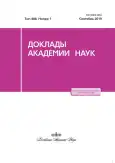Responses of aquatic organisms to cyanobacteria and elodea in microcosms
- Authors: Verbitsky V.B.1, Kurbatova S.A.1, Berezina N.A.2, Korneva L.G.1, Meteleva N.Y.1, Makarova O.S.1, Sharov A.N.1,3, Ershov I.Y.1, Malysheva O.A.1, Russkikh Y.V.3, Chernova E.N.3, Borisovskaya E.V.1
-
Affiliations:
- Papanin Institute for Biology of Inland Waters of the Russian Academy of Sciences
- Zoological Institute of the Russian Academy of Sciences
- Saint-Petersburg Scientific-Research Centre for Ecological Safety of the Russian Academy of Sciences
- Issue: Vol 488, No 1 (2019)
- Pages: 112-116
- Section: General biology
- URL: https://journals.eco-vector.com/0869-5652/article/view/16223
- DOI: https://doi.org/10.31857/S0869-56524881112-116
- ID: 16223
Cite item
Abstract
The aim of the work was to investigate the effect of cyanobacteria and elodea on population characteristics (abundance, biomass, fecundity) and “health” indicators (embryo status, heart rate and thermal resistance) of aquatic invertebrates in microcosms with controlled conditions. In July-August 2018, four treatments with environmental conditions of the coastal zone of the Rybinsk Reservoir during the period of cyanobacterial bloom were modeled. Mass species of plankton (with 80% dominance of large Daphnia longispina) and benthic animals (Unio pictorum, Gmelinoides fasciatus, Asellus aquaticus) and Elodea canadensis were placed in microcosms. In treatments with cyanobacteria, the toxic microcystins-LR were detected (24-53% of the sum of toxins, or 6,6-66,5 µg/l). The cyanobacteria Aphanizomenon flos-aquae, Microcystis aeruginosa and Gloeoitrichia spp. affected the structure of plankton reflecting in a decrease in the amount of green algae and an increase in the abundance of small crustaceans. Under the influence of cyanobacteria, variables of benthic animals differed significantly from control treatment, including a reduced level of thermal resistance of mollusks and amphipods, an increased recovery time of the heart rate after loading (salinity test) in mollusks, a decrease in individual fecundity, and an increase in the frequency of malformations and embryo mortality in amphipods. The presence of elodea enhanced these effects. Thus, the mass development of cyanobacteria and elodea affects the physiological status of sensitive species of aquatic animals, reducing their adaptability to natural stresses and worsening the quality of offspring.
Keywords
About the authors
V. B. Verbitsky
Papanin Institute for Biology of Inland Waters of the Russian Academy of Sciences
Author for correspondence.
Email: verb@ibiw.ru
Russian Federation, 09, Borok, Nekouz, Yaroslavl, 152742
S. A. Kurbatova
Papanin Institute for Biology of Inland Waters of the Russian Academy of Sciences
Email: verb@ibiw.ru
Russian Federation, 09, Borok, Nekouz, Yaroslavl, 152742
N. A. Berezina
Zoological Institute of the Russian Academy of Sciences
Email: verb@ibiw.ru
Russian Federation, 1, Universitetskaya emb., Saint-Petersburg, 199034
L. G. Korneva
Papanin Institute for Biology of Inland Waters of the Russian Academy of Sciences
Email: verb@ibiw.ru
Russian Federation, 09, Borok, Nekouz, Yaroslavl, 152742
N. Yu. Meteleva
Papanin Institute for Biology of Inland Waters of the Russian Academy of Sciences
Email: verb@ibiw.ru
Russian Federation, 09, Borok, Nekouz, Yaroslavl, 152742
O. S. Makarova
Papanin Institute for Biology of Inland Waters of the Russian Academy of Sciences
Email: verb@ibiw.ru
Russian Federation, 09, Borok, Nekouz, Yaroslavl, 152742
A. N. Sharov
Papanin Institute for Biology of Inland Waters of the Russian Academy of Sciences; Saint-Petersburg Scientific-Research Centre for Ecological Safety of the Russian Academy of Sciences
Email: verb@ibiw.ru
Russian Federation, 09, Borok, Nekouz, Yaroslavl, 152742; 18, Korpusnaya street, Saint-Petersburg, 197110
I. Yu. Ershov
Papanin Institute for Biology of Inland Waters of the Russian Academy of Sciences
Email: verb@ibiw.ru
Russian Federation, 09, Borok, Nekouz, Yaroslavl, 152742
O. A. Malysheva
Papanin Institute for Biology of Inland Waters of the Russian Academy of Sciences
Email: verb@ibiw.ru
Russian Federation, 09, Borok, Nekouz, Yaroslavl, 152742
Y. V. Russkikh
Saint-Petersburg Scientific-Research Centre for Ecological Safety of the Russian Academy of Sciences
Email: verb@ibiw.ru
Russian Federation, 18, Korpusnaya street, Saint-Petersburg, 197110
E. N. Chernova
Saint-Petersburg Scientific-Research Centre for Ecological Safety of the Russian Academy of Sciences
Email: verb@ibiw.ru
Russian Federation, 18, Korpusnaya street, Saint-Petersburg, 197110
E. V. Borisovskaya
Papanin Institute for Biology of Inland Waters of the Russian Academy of Sciences
Email: verb@ibiw.ru
Russian Federation, 09, Borok, Nekouz, Yaroslavl, 152742
References
- Колмаков В.И. // Сиб. экол. журн. 2014. Т. 21. № 4. С. 601-613.
- Berezina N.A., Maximov A.A., Umnova L.P., et al. // J. Sib. Fedеral Univ. Biol. 2017. V. 10. P. 485-501.
- Merel S.D., Chicana W.R., Snyder S., Baurès E., Thomas O. // Environ. Int. 2013. V. 59. P. 303-327.
- Chernova E., Russkikh I., Voyakina E., Zhakovskaya Z. // Oceanol. Hydrobiol. St. 2016. V. 45. № 4. P. 466-484.
- Gagala I., Mankiewicz-Boczek J. // Polish J. Environ. Studies. 2012. V. 21. P. 1125-1139.
- Wood R. // Environ. Int. 2016. V. 91. V. 276-282.
- Кравцова Л.С., Ижболдина Л.А., Механикова И.В., Помазкина Г.В., Белых О.И. // Журн. биол. инвазий. 2010. № 2. С. 2-16.
- Bownik A. // Toxicon. 2016. V. 124. P. 26-35.
- Pflugmacher S. // Environmental Toxicology. 2002. V. 17. P. 407-413.
- Kholodkevich S.V., Kuznetsova T.V., Sharov A.N., et al. // J. Mar. Syst. 2017. V. 171. P. 151-158.
- Вербицкий В.Б., Березина Н.А. // Журн. общей биол. 2009. Т. 70. № 3. С. 249-256.
- Gorokhova E, Sundelin B, Berezina N. // HELCOM Technical report. 2018. doi: 10.13140/RG.2.2.34346.52162
- Alan J.D. // Freshwater Biology. 1977. V. 7. P. 505-512.
- Курбатова С.А., Ершов И.Ю., Борисовская Е.В. // Биол. внутр. вод. 2017. Т. 1. С. 84-92.
Supplementary files








